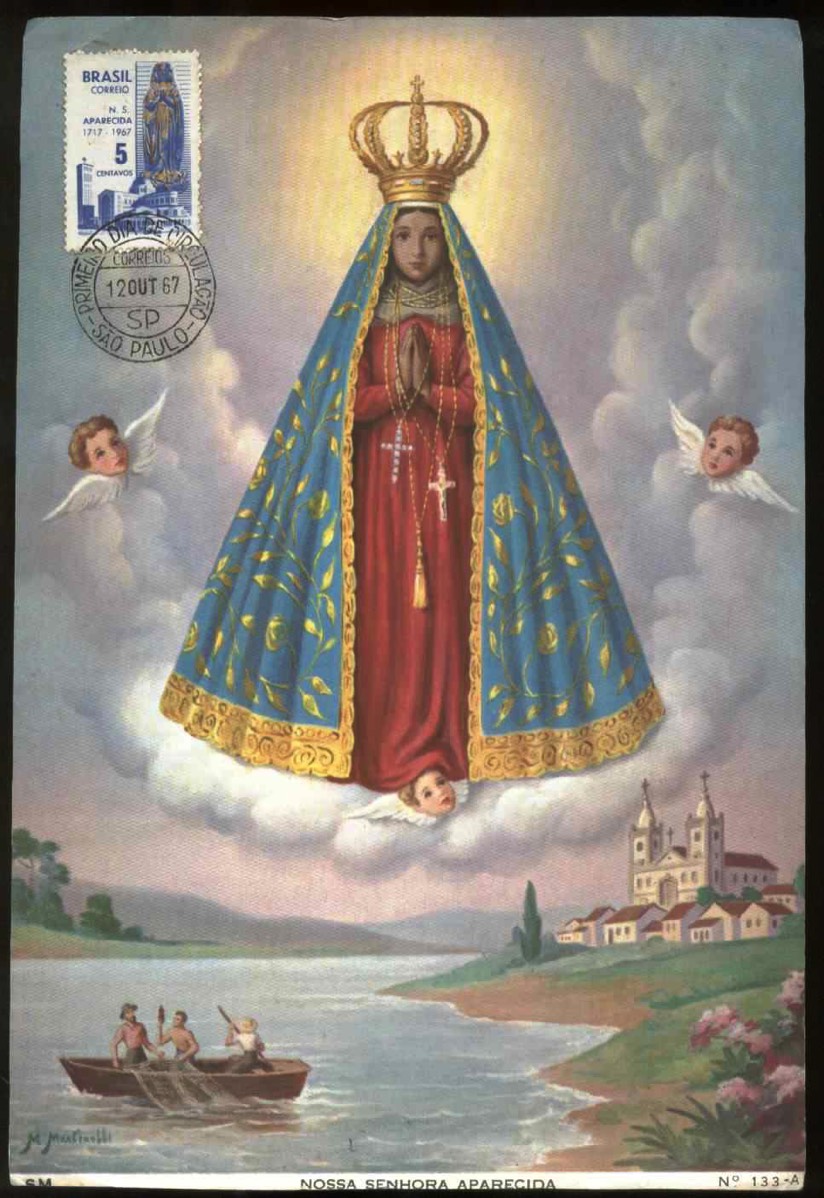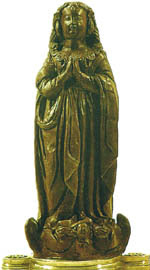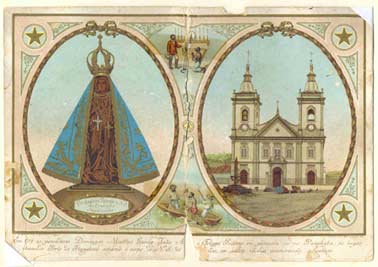
Our Lady of the Immaculate Conception Aparecida
The story of Our Lady of the Conception Aparecida beginned around 1717, when came the news that the Count of Assumar, D.Pedro of Almeida and Portugal, Governor of the Province of São Paulo and Minas Gerais would pass by the Town of Guaratinguetá, in his way to Vila Rica, today Ouro Preto city - MG. The Administrative Chamber of Guaratinguetá decided and promptly. The time was not favorable for fishing, but this was a problem left for the fishermen . The Count had to try the fish from the river Paraíba. Fishermen were summoned all around. João Alves, Domingos Garcia and Felipe Pedroso, inhabitants of Itaguaçu, were among them: they got their boats, their nets and threw themselves in the difficult task of searching for fish in the Rio Paraíba. They went down the river and found nothing. They rowed all night without getting any fish. After many unsuccessful attempts, they arrived to the Port Itaguaçu, where threw their nets again. João Alves felt that his net weighed. Could it be fish? He hauled it. No. There were no fish. It was the body of an image of Our Lady of Conception. But... what about the head, where was it? They kept the finding in the bottom of the boat. They kept on trying to find fish. Suddenlly, in the net of the same fisherman, a blackened head of an image. João Alves caught the body from the bottom of the boat and put it near the head. Perfect fit. That alone could be miracle. They blessed themselves and wrapped the pieces in a cloth. They continued the fishing. But now the fish knew exactly the address of their nets. And there were so many that they feared for the fragility of the boats...
The Priest Francisco da Silveira, who wrote the cronicle of a Mission in Aparecida in 1748, qualified the image of the Virgin Aparecida as “famous for the many miracles made". And he adds that numerous were the pilgrims who came from far away to thank for favours received .
The first wonder, no doubt, was the abundant fishing that followed the finding of the image. There are no other references about the fact than the narrative of the finding of the image: "And, continuing fishing, not having up to that time caught any fish, from then the fishing was so abundant, that getting afraid of a shipwreck for the amount of fish they had in the canoes, the fishermen withdrew to their houses, astonished with what happened."
However, the most symbolic and rich in meaning, no doubt, was the miracle of candles for its intimate relation with faith: After the fishermen arrived from the fishing where they found the Lady, Felipe Pedroso took the image to his house , keeping it for 5 years. On the occasion of him moving to the neighborhood of the Ponte Alta, he gave the image to his son Athanásio Pedroso, who lived in Port Itaguaçu, quite near to the place where his father Felipe Pedroso, João Alves and Domingos Garcia had found the image. Athanásio made an altar out of wood and put the Miraculous Image of Aparecida. On Saturdays he and his neighbors got together to pray a rosary in Her devotion. In one occasion, upon praying the rosary, 2 candles were put out in the altar of Our Lady, this was very strange, because that night was very calm and there was no reason for that happening. The devouts were all surprised and, when Silvana da Rocha, that was following the rosary in that day, tried to lit them once again, they were litten by themselves, without nobody touching it: prodigiously, as a perfect miracle. From this date forward the Miraculous Image of Our Lady Aparecida stopped belonging to the family of Felipe Pedroso to belong to every one of us, devouts of this Holy Miraculous Saint.
Significant also it is the wonder of the shackles that were loosened from the hands of a slave, when he begged for the protection of Aparecida. There are many oral versions about this fact. Some are rich in details. The first to mention it in written was the Priest Claro Francisco de Vasconcelos, in 1828. One of the versions of this miracle tells that the slave Zacarias pleaded for the Virgin Mariy to free him from the torture of his cruel owner. The slave had fled from the farm, but upon being captured, he asked the foreman to let him make a prayer in the chapel where was the image of Our Lady. When he began to pray, he heard a click and the iron handcuffs that were bounding his feet got opened on their own in a miraculous way. The foreman, frightened with what he saw, let the slave go away immediately.

Hypothetically, it would have been, originally, polychr0matic, as was custom in that time, but there is not documents that verify. When it was caught, the body was separate from the head and, a lot probably, without its original polychrome, due to the years in that it was submerged in the waters and slime of the river.
The cinnamon color by that, today, it is known, must be due to the fact of having being displayed, for years, close to the flames of candles and lamps. Its style is from the XVIIth century, as asserted by specialists who have studied it.
Among the ones that who confirm the Image to be from the Century XVII are Dr. Pedro de Oliveira Ribeiro Neto, the benedictine monks of the Monastery of São Salvador, in the Bahia, Dom Clemente da Silva Nigra e Dom Paulo Lachenmayer.
Finally, in 1978, after the attack that reduced it to almost two hundred pieces, was taken to theTeacher Pietro Maria Bardi – in the time, director of the Museum of Art of São Paulo – that examined, together with Dr. João Marine, collector of Brazilian images.
It was completely reconstructed by the plastic artist Maria Helena Chartuni, at the time, restorer of the Museum of Art of São Paulo. According to studies of the experts mentioned, the Image was molded with clay native of São Paulo, from the region of Santana do Parnaíba, situated in Greater São Paulo.
The most difficult was to determine the author of the small image, for it is neither signed or dated. So, after a comparative study, the experts came to the conclusion that it was the work of a sculptor who was a disciple of the benedictine monk Friar Agostinho da Piedade, and also his colleague of Order, Friar Agostinho de Jesus.
Some characteristics of their style: smiling shape of the lips, built-in chin, with a dimple in the center; well-groomed, flowers in prominence, in the hair, a brooch with three pearls in the forehead and a straight posture.
All of these details can be found in the Image of Our Lady of the Conception Aparecida, and, by that, the experts Dom Clemenente da Silva Nigra and Dom Paulo Lachenmayer came to the conclusion that the Image was carved by the benedictine monk Friar Agostinho de Jesus.
From the 8th of september of 1904, when she was crowned, the image started to wear, officialy, the crown offered by the Princess Isabel, in 1884, as well as the navy blue cloak.

Prayer to Our Lady Aparecida
Dear Mother!
You, that loves us and guides us every day;
You, who are the most beautiful Mother;
who I love with all my heart!
I ask You, one more time.
That you help me to reach this grace,
as difficult as it maybe!
(Ask for the Grace).
I know You will always
help me and accompany me,
until the hour of my death.
Amen!
Following, one Our Father and one Hail Mary should be prayed.
This prayer should be made for 3 days in a row, so the grace requested will be received, no matter how hard it may seem.
After receiving the grace, the person should print and/or send this prayer to 1000 people.
